Greek gardens embody the timeless beauty of Mediterranean design, where sun-drenched landscapes meet ancient architectural wisdom. These outdoor spaces celebrate the harmony between natural elements and human craftsmanship, creating sanctuaries that have inspired garden designers for millennia. From terraced hillsides adorned with olive groves to intimate courtyards featuring trickling fountains, Greek gardens emphasize simplicity, functionality, and enduring elegance. The philosophy centers on working with nature rather than against it, utilizing drought-tolerant plants, natural stone materials, and strategic shade structures. Whether you envision a sprawling estate reminiscent of ancient Athens or a compact terrace channeling island charm, these design concepts will help you create an authentic Greek garden experience that transports you to the Mediterranean with every step.

1. Classic Santorini Terrace Garden with Whitewashed Walls

Transform your outdoor space into a breathtaking Santorini-inspired terrace featuring brilliant white walls and stunning blue accents. This design incorporates traditional Greek architecture with curved planters filled with cascading bougainvillea in vibrant magenta and purple hues. Natural limestone paving creates elegant pathways between raised flower beds planted with aromatic lavender and rosemary. The centerpiece includes a small water feature with ceramic urns painted in classic Aegean blue, while weathered wooden furniture provides comfortable seating areas. Strategic placement of olive trees in large terracotta pots adds authentic Mediterranean character, creating dappled shade perfect for afternoon relaxation. The overall palette emphasizes crisp whites, deep blues, and natural stone tones that reflect the iconic Cycladic aesthetic.
2. Rustic Olive Grove Garden with Stone Pathways
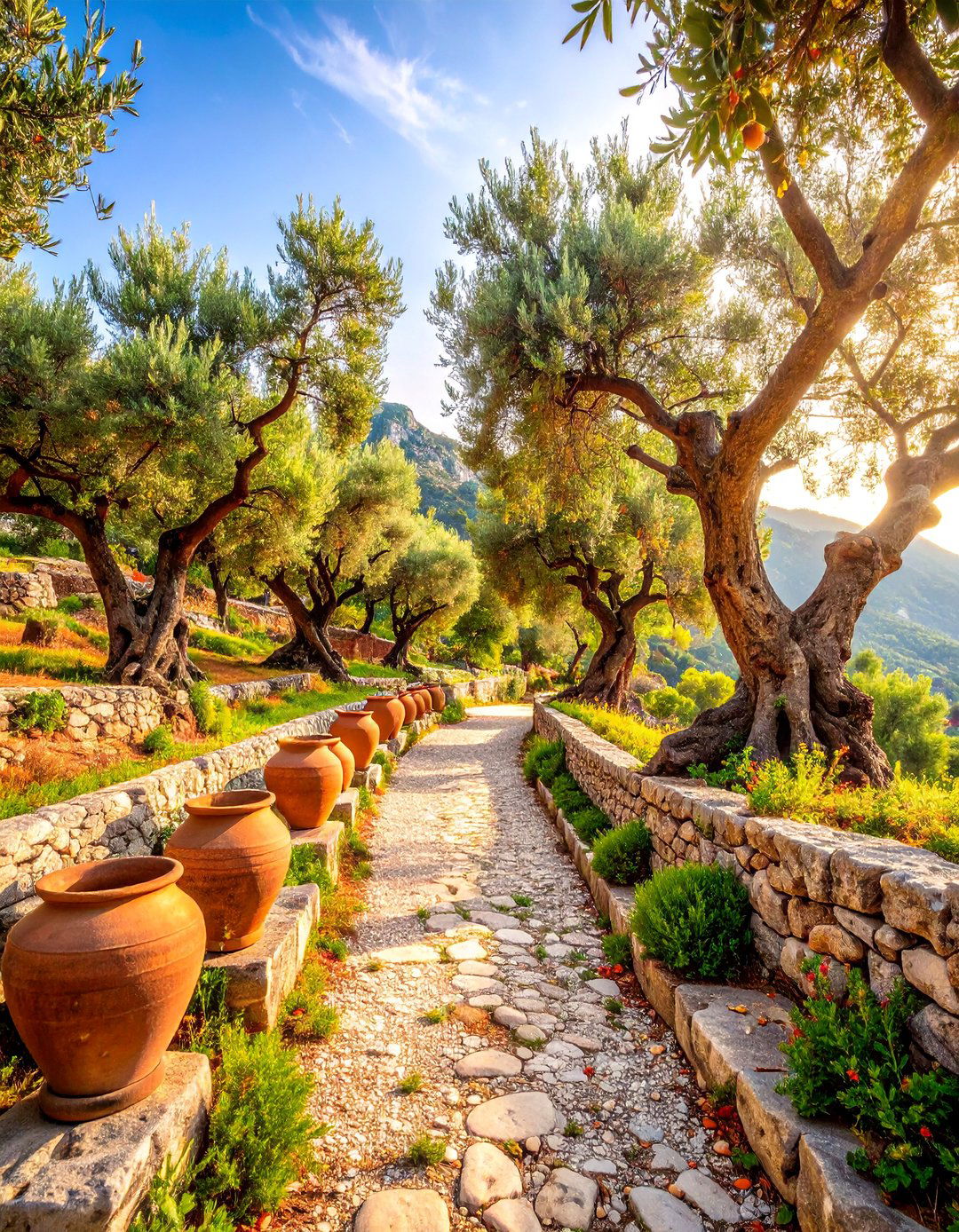
Create an enchanting olive grove garden that captures the essence of rural Greece through mature olive trees planted in naturalistic groupings. Weathered limestone pathways wind between silvery-leafed specimens, leading to a central gathering area with traditional wooden benches and a rustic stone table. The understory features Mediterranean herbs including wild thyme, oregano, and sage that release fragrant oils when brushed. Ancient-style stone walls define garden boundaries while supporting climbing jasmine and grape vines. Terra cotta amphora serve as focal points throughout the space, some functioning as planters for aromatic herbs, others as decorative elements. Natural mulch of olive leaves and stone chips suppresses weeds while maintaining the authentic, time-worn appearance characteristic of traditional Greek agricultural landscapes.
3. Courtyard Fountain Garden with Marble Accents
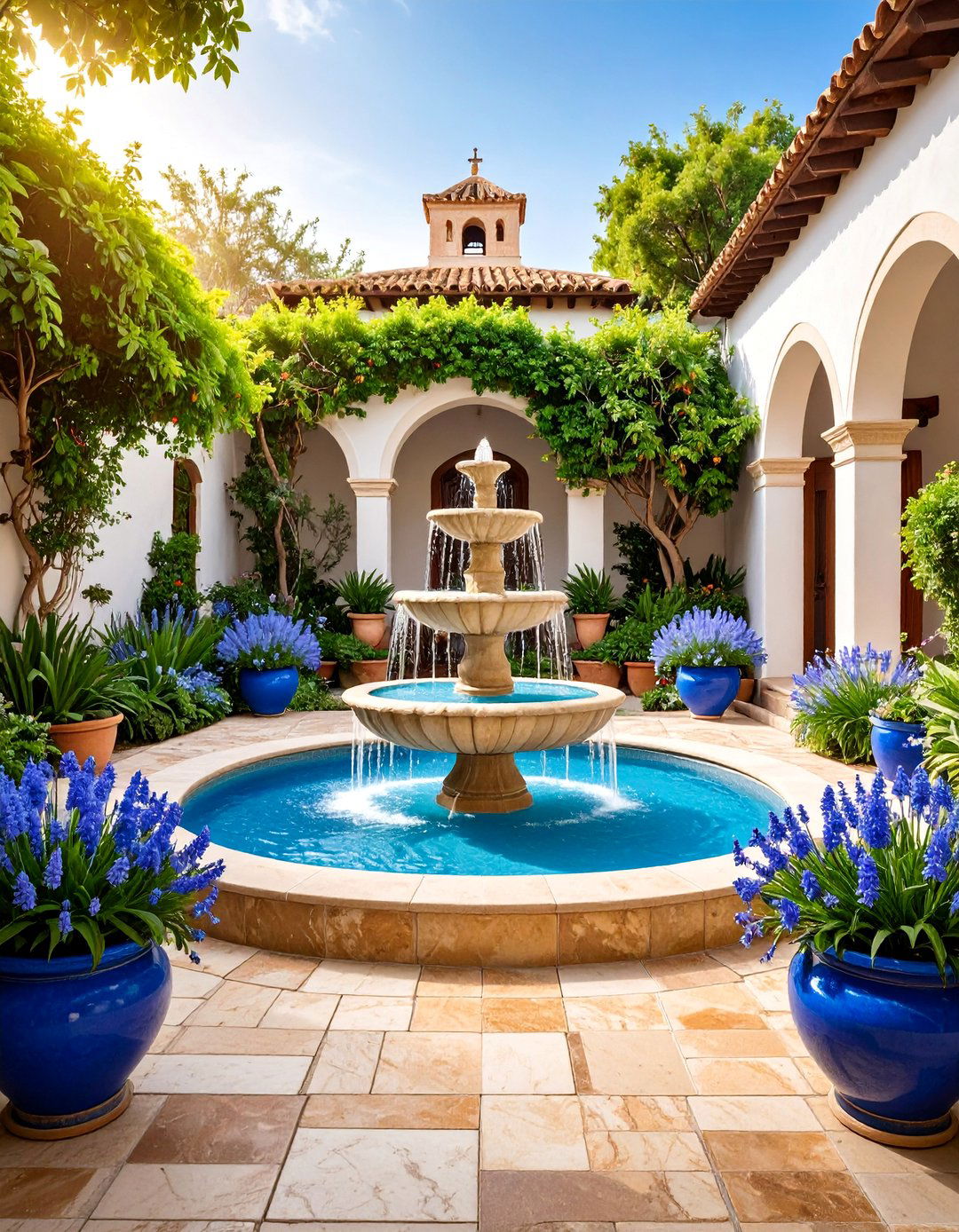
Design an intimate courtyard garden centered around a stunning marble fountain inspired by classical Greek architecture. The fountain features three tiers with water cascading gently into a circular basin surrounded by natural stone paving in warm honey tones. Symmetrical planting beds frame the water feature with drought-tolerant perennials including agapanthus, salvia, and ornamental grasses that provide year-round structure. White-painted walls create a clean backdrop adorned with traditional blue pottery and climbing vines. Strategically placed citrus trees in decorative containers add fragrance and seasonal interest, while comfortable seating areas feature cushions in classic blue and white patterns. The design emphasizes geometric balance and proportion, fundamental principles of Greek garden philosophy that create harmony between architectural and natural elements.
4. Herb Terraces with Ancient Stone Retaining Walls
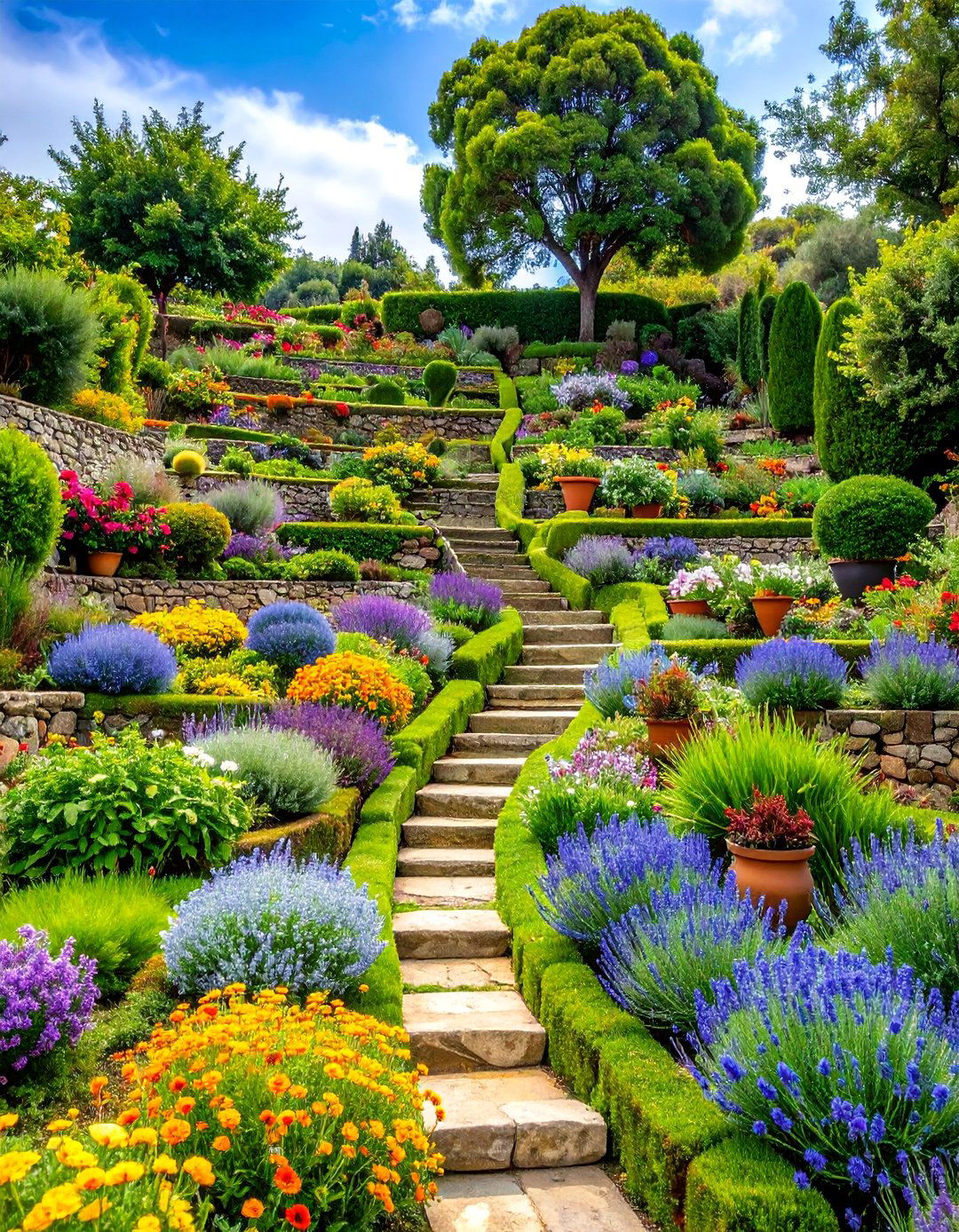
Establish spectacular terraced herb gardens using traditional dry-stone retaining walls that showcase masterful Greek stonework techniques. Each level features different Mediterranean herbs including lavender, rosemary, thyme, and sage arranged in geometric patterns that highlight their varied textures and colors. Natural stone steps connect the terraces, creating an engaging journey through aromatic landscapes. Ancient olive trees anchor the design at key focal points, providing shade and vertical interest. Terra cotta pots in various sizes contain specialty herbs and seasonal flowers, while gravel mulch conserves moisture and suppresses weeds. The terraced structure maximizes growing space while preventing erosion, demonstrating the practical wisdom of traditional Greek agricultural methods. Wooden benches positioned at scenic overlooks provide perfect spots for contemplating the garden's beauty.
5. Pergola Dining Garden with Climbing Vines

Construct an elegant pergola dining area that embodies the Greek tradition of outdoor entertaining beneath natural canopies. The wooden structure supports vigorous grape vines and fragrant jasmine that create dappled shade over a natural stone dining terrace. Long wooden tables accommodate extended family gatherings, surrounded by comfortable chairs and colorful cushions in traditional patterns. The surrounding garden features symmetrical plantings of lavender and rosemary that perfume the air during evening meals. Large olive trees frame the dining space while providing additional shade and Mediterranean character. Terra cotta urns filled with seasonal flowers add splashes of color throughout the space. String lights woven through the vine canopy create magical ambiance for nighttime dining, while the sound of a nearby water feature adds peaceful background music.
6. Coastal Pebble Garden with Succulents
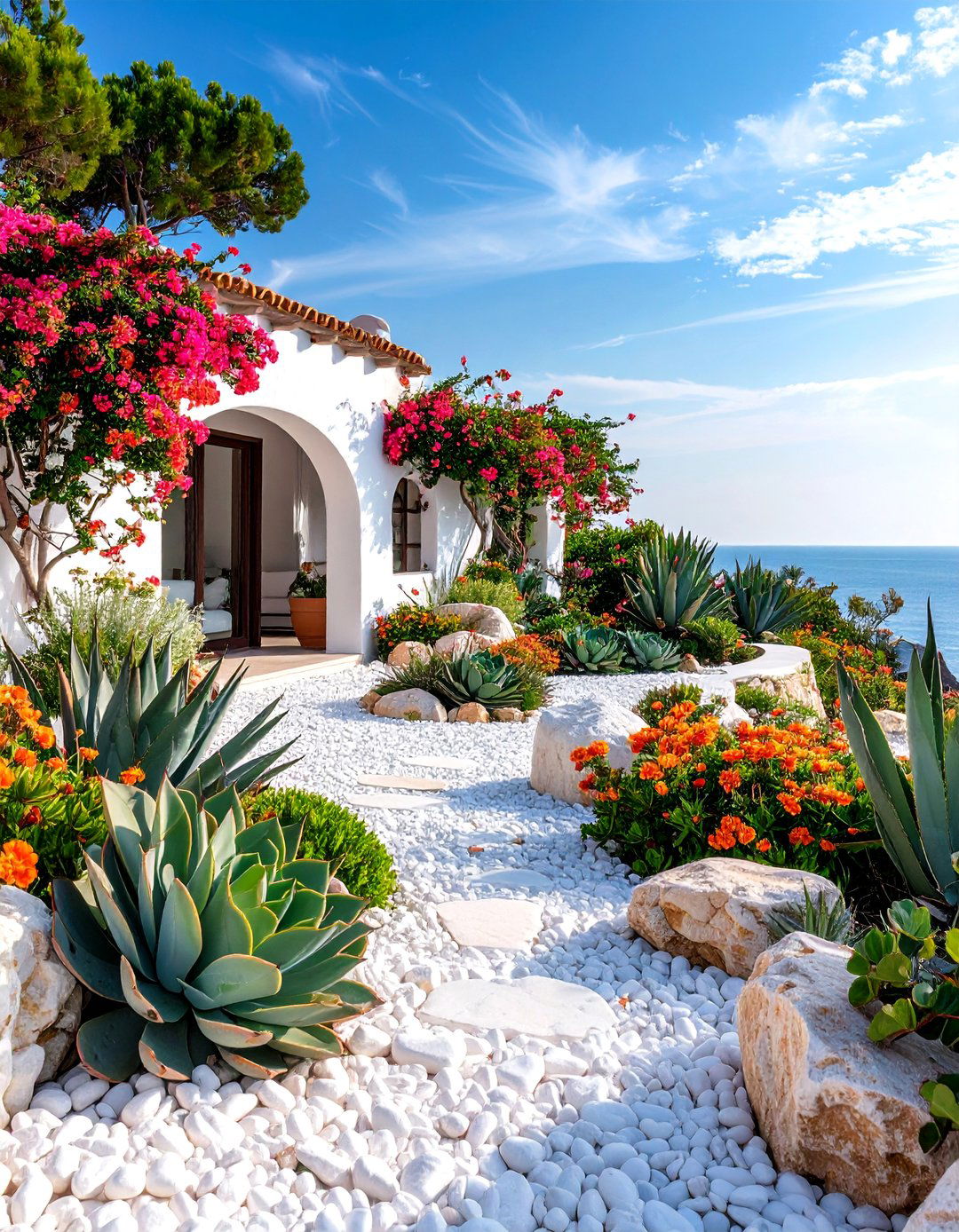
Create a striking coastal-inspired garden using smooth pebbles and drought-tolerant succulents that thrive in Mediterranean conditions. White and gray stone mulch contrasts beautifully with sculptural agave, aloe, and echeveria planted in organic groupings. Natural limestone boulders serve as focal points and provide textural interest throughout the space. Traditional whitewashed walls reflect sunlight while supporting climbing bougainvillea in brilliant coral and magenta. Weathered driftwood sculptures and blue-painted pottery add authentic coastal character. The design includes raised planting areas filled with aromatic herbs that cascade over stone edges, creating natural transitions between different garden zones. A simple water feature using stacked stones provides the soothing sound of trickling water while requiring minimal maintenance. This garden celebrates the raw beauty of Greek island landscapes.
7. Monastery Garden with Enclosed Herb Squares

Design a contemplative monastery-style garden featuring enclosed herb squares surrounded by low stone walls and gravel pathways. Each geometric section contains different medicinal and culinary herbs traditionally cultivated in Greek monasteries, including oregano, mint, sage, and holy basil. A central fountain or well provides both practical water access and spiritual symbolism. Ancient olive trees offer shade for meditation areas with simple stone benches. The surrounding walls feature climbing roses and grape vines that provide privacy and seasonal beauty. Terra cotta pots contain rare herbs and flowering plants that add color throughout the growing season. Narrow gravel paths between herb squares allow easy maintenance access while creating formal geometric patterns. This design emphasizes simplicity, functionality, and spiritual contemplation characteristic of monastic traditions that preserved Greek horticultural knowledge through centuries.
8. Hillside Amphitheater Garden with Natural Stone Seating

Transform sloping terrain into a dramatic amphitheater garden featuring curved stone seating that follows natural hillside contours. This design celebrates ancient Greek theatrical traditions while creating spectacular garden views from every level. Native Mediterranean plants including lavender, cistus, and wild olive cascade down terraced slopes, creating naturalistic drifts of color and texture. Central performance or gathering areas feature circular stone platforms surrounded by aromatic herb gardens. Ancient olive trees provide shade and vertical structure throughout the terraced landscape. Natural stone pathways connect different levels while water features carved into hillside provide cooling sounds and irrigation. The design incorporates traditional materials including limestone, marble chips, and terra cotta elements that weather beautifully over time. This garden celebrates both dramatic landscape architecture and the Greek tradition of outdoor performance.
9. Villa Pool Garden with Cypress Allees
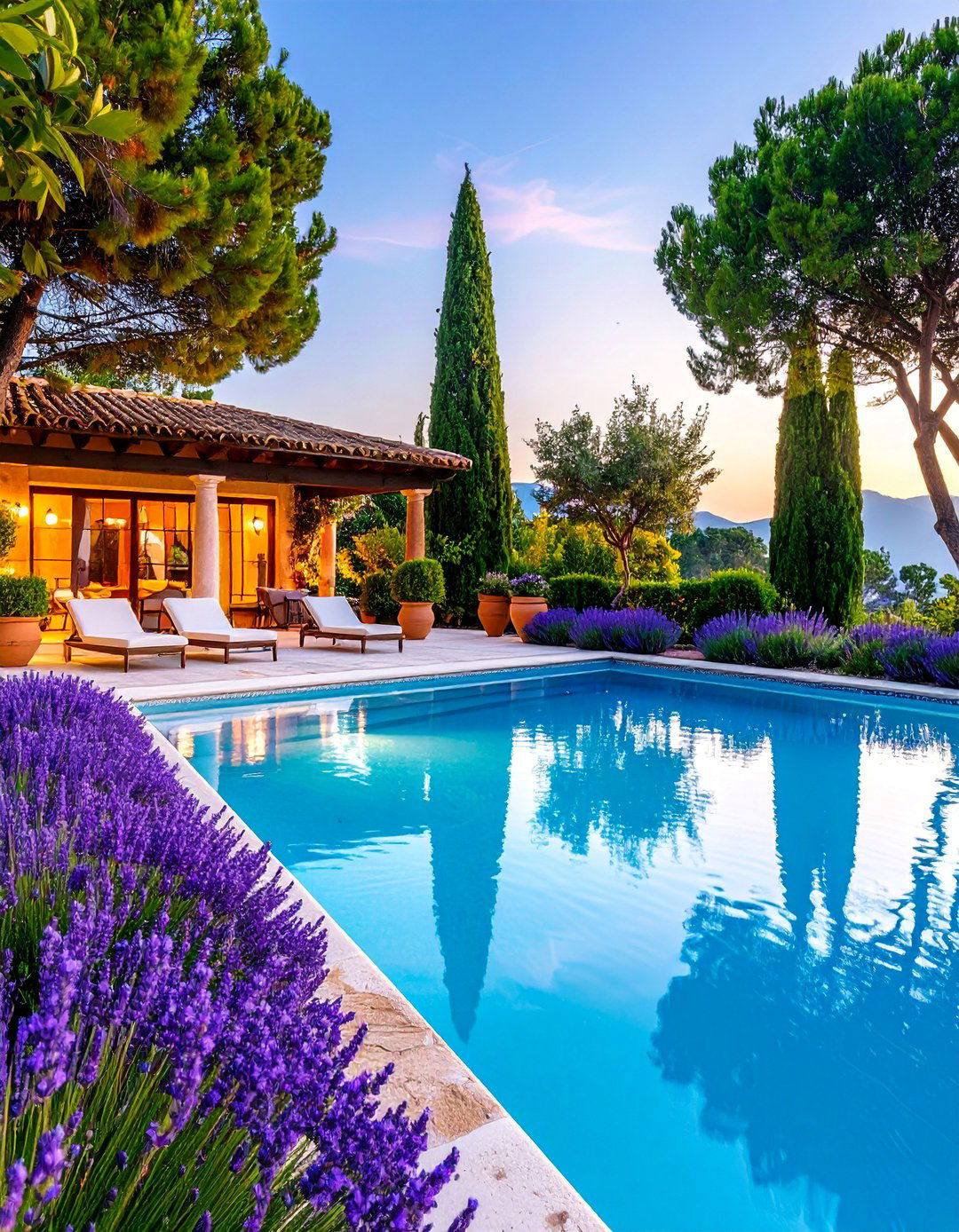
Create an elegant villa garden featuring formal cypress allees that frame a stunning swimming pool area inspired by classical Greek estates. Tall Italian cypress trees planted in perfectly straight lines create dramatic vertical elements and provide structure year-round. The pool terrace uses natural limestone paving that stays cool underfoot during hot summer months. Surrounding gardens feature geometric plantings of lavender, rosemary, and ornamental grasses that complement the formal cypress lines. Terra cotta urns positioned at regular intervals contain seasonal flowers and trailing vines. Comfortable lounge areas feature traditional white furniture with blue cushions that echo classic Greek color schemes. Ancient olive trees provide shade for dining terraces while pergola structures support grape vines and jasmine. The design emphasizes symmetry, proportion, and axial relationships fundamental to classical Greek landscape architecture.
10. Island Windmill Garden with Drought-Tolerant Plantings
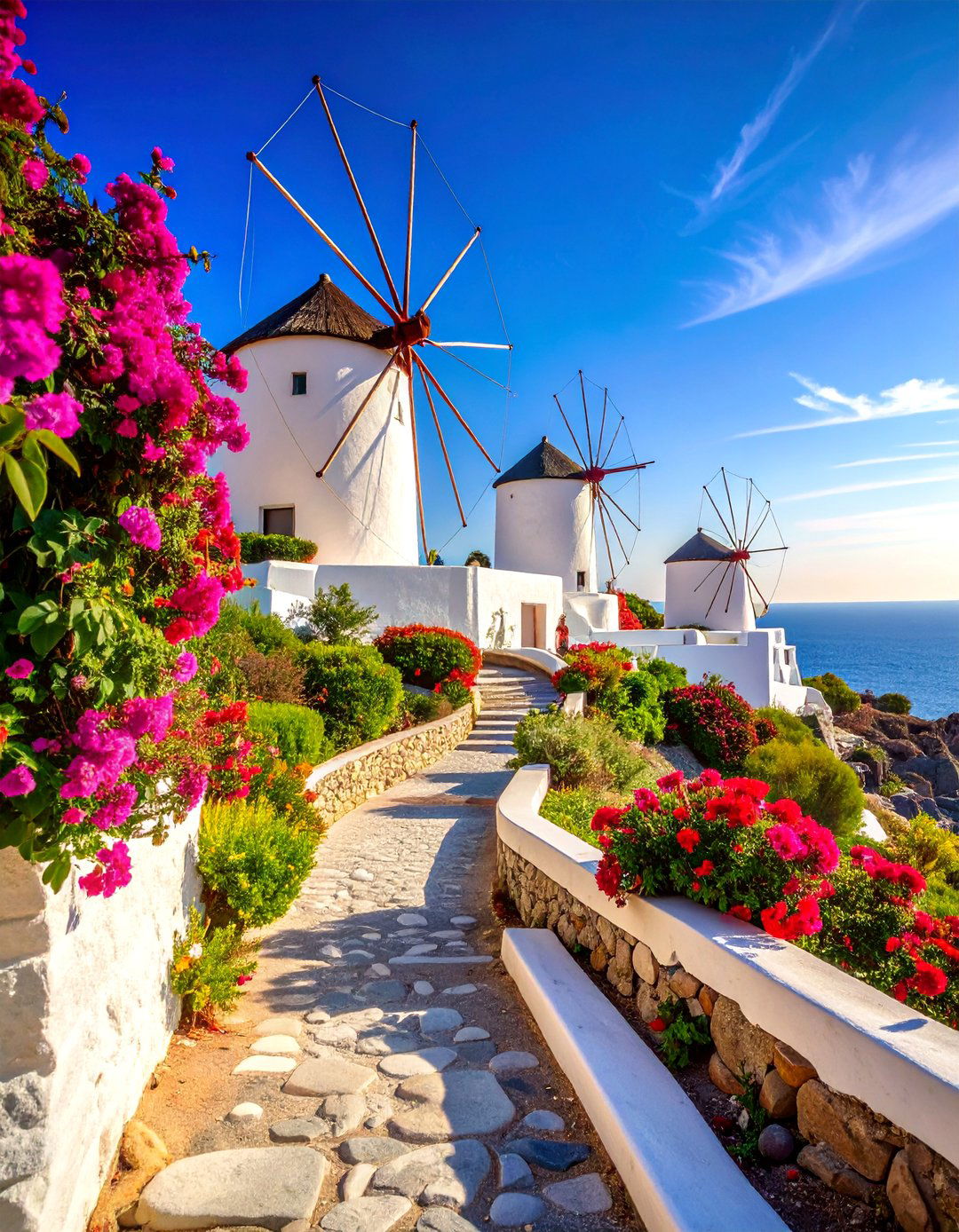
Design a charming windmill garden that captures the essence of Greek island landscapes through authentic architectural elements and resilient plantings. A traditional stone windmill serves as the central focal point, surrounded by terraced gardens filled with native Mediterranean plants. Drought-tolerant species including lavender, santolina, and wild thyme create colorful tapestries that require minimal irrigation. White-painted stone walls define different garden areas while supporting climbing bougainvillea and grape vines. Natural stone pathways wind through the landscape, connecting various activity areas including shaded seating spots and herb gathering areas. Terra cotta storage jars and amphora provide decorative elements while referencing traditional agricultural practices. The garden celebrates the ingenuity of island communities that created beautiful, productive landscapes despite challenging growing conditions. Wind-resistant plants and sturdy construction ensure the garden thrives in exposed locations.
11. Ancient Agora Garden with Market-Style Plantings
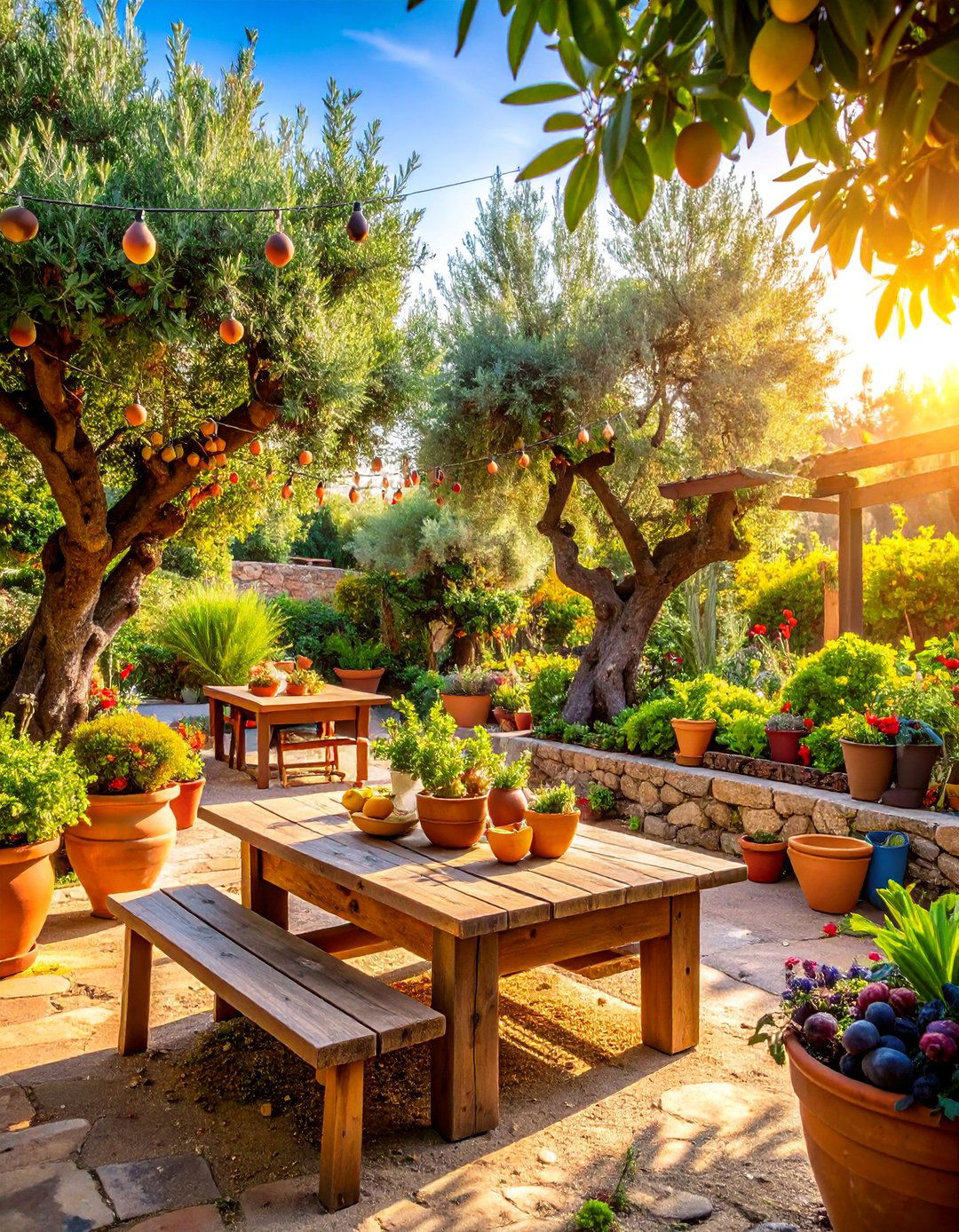
Recreate the atmosphere of ancient Greek marketplaces through a productive garden featuring vegetables, herbs, and fruit trees arranged in organized growing areas. Traditional raised beds constructed from local stone contain seasonal vegetables and culinary herbs that would have been sold in historical agoras. Ancient olive and fig trees provide shade over gathering areas with rustic wooden tables and benches. Terra cotta pots contain specialty herbs and medicinal plants, while vine-covered pergolas support grape production. Natural stone pathways connect different growing areas, creating easy access for harvesting and maintenance. Water features include simple stone basins that serve both practical and aesthetic purposes. The design emphasizes functionality and productivity while maintaining beautiful proportions and authentic materials. This garden celebrates the Greek tradition of combining agriculture, commerce, and social interaction in outdoor spaces that serve multiple community functions.
12. Philosopher's Garden with Contemplative Spaces

Create a peaceful philosopher's garden featuring quiet contemplation areas surrounded by meaningful plantings that inspire reflection and study. Ancient olive trees provide shade for simple stone benches positioned to overlook different garden vistas. Aromatic herbs including lavender, rosemary, and sage stimulate the senses while supporting meditative practices. Geometric pathways created from local stone connect various contemplative areas including secluded alcoves and open gathering spaces. A central water feature provides soothing sounds that mask outside distractions while supporting wildlife. Traditional materials including marble, limestone, and terra cotta create timeless beauty that ages gracefully. The plant palette emphasizes perennial species that provide year-round structure with seasonal changes that mark the passage of time. This garden celebrates the Greek philosophical tradition of seeking wisdom through close observation of natural cycles and thoughtful contemplation.
13. Coastal Terrace Garden with Sea Views

Design a spectacular coastal terrace garden that maximizes stunning sea views while providing protection from salt spray and strong winds. Natural stone retaining walls create level planting areas on sloping terrain, filled with salt-tolerant Mediterranean plants including rosemary, lavender, and native grasses. Traditional whitewashed buildings provide shelter while reflecting cooling sea breezes throughout the garden. Comfortable seating areas feature weather-resistant furniture positioned to capture the best views during different times of day. Ancient olive trees and drought-tolerant shrubs provide wind protection while maintaining the open feeling essential to coastal gardens. Terra cotta elements add warm color contrasts against blue sea backgrounds. Simple water features using natural stone provide fresh water for irrigation and wildlife. The design emphasizes durability, low maintenance, and integration with the spectacular natural setting that characterizes Greek coastal landscapes.
14. Traditional Taverna Garden with Dining Terraces

Create an authentic taverna garden featuring multiple dining terraces connected by natural stone pathways and decorated with traditional Greek elements. Large pergolas support grape vines that provide shade over rustic wooden tables and chairs arranged for family-style dining. Surrounding gardens feature aromatic herbs including oregano, basil, and mint that can be harvested fresh for cooking. Ancient olive trees anchor different seating areas while providing natural shade and Mediterranean character. Terra cotta urns and traditional pottery add authentic decorative elements throughout the space. Simple water features provide cooling sounds during hot summer afternoons. The color palette emphasizes white buildings, blue accents, and natural stone materials that create classic Greek taverna atmosphere. String lights woven through vine canopies create magical evening ambiance perfect for extended outdoor dining. This garden celebrates the Greek tradition of communal meals and hospitality in beautiful outdoor settings.
15. Monastery Vineyard Garden with Grape Arbors
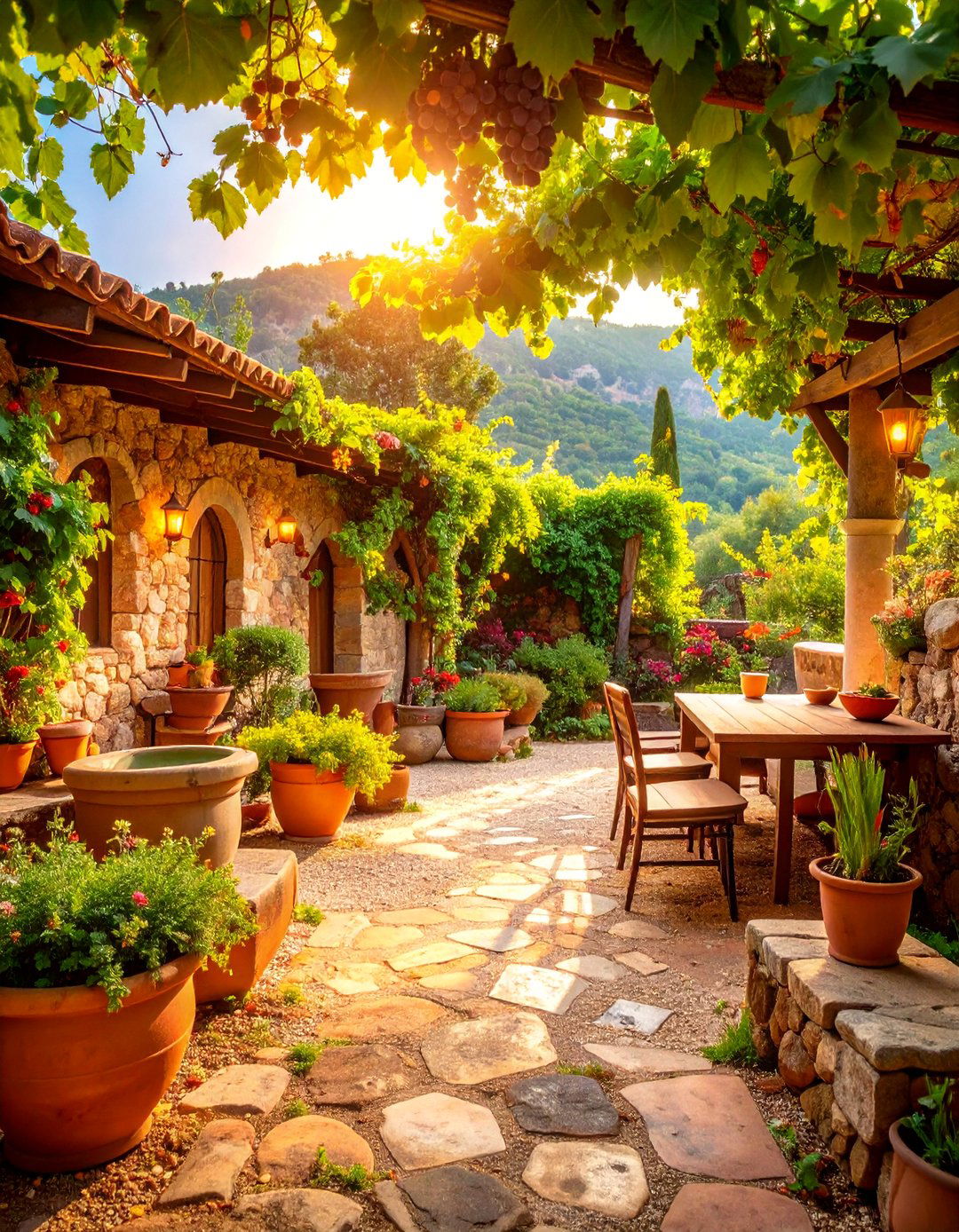
Establish a productive vineyard garden inspired by monastic traditions that combine spiritual contemplation with agricultural productivity. Grape vines trained on traditional wooden arbors create shaded walkways while producing fruit for wine or table use. Geometric planting beds between vine rows contain herbs and vegetables that support sustainable garden practices. Ancient stone walls define property boundaries while providing support for climbing plants and wind protection. Simple water features include stone basins that serve both irrigation and aesthetic purposes. Terra cotta storage vessels reference traditional wine-making equipment while providing decorative focal points. The design emphasizes organic growing methods and integration of productive and ornamental plants. Quiet seating areas positioned throughout the vineyard provide spots for contemplation and appreciation of seasonal changes. This garden celebrates the monastic tradition of creating productive landscapes that support both physical and spiritual well-being through careful stewardship of natural resources.
16. Sculptural Garden with Classical Statuary

Design an elegant garden featuring classical statuary and sculptural elements that celebrate Greek artistic traditions while providing beautiful backdrops for plant displays. Marble or stone sculptures positioned at key focal points create dramatic vertical elements surrounded by complementary plantings. Formal geometric beds contain aromatic herbs and flowering perennials arranged to enhance sculptural displays. Natural stone pathways connect different artistic vignettes while providing access for maintenance and appreciation. Ancient olive trees and cypress specimens provide living architecture that complements stone sculptures. Water features including fountains and reflecting pools add movement and sound while creating perfect settings for sculptural displays. The plant palette emphasizes species with architectural qualities including ornamental grasses, succulents, and clipped hedges. This garden celebrates the integration of art and nature fundamental to Greek aesthetic philosophy while creating timeless beauty that improves with age.
17. Clifftop Garden with Natural Rock Formations

Create a dramatic clifftop garden that incorporates natural rock formations while providing spectacular views and protection from strong winds. Native Mediterranean plants including wild thyme, cistus, and maritime pine thrive in harsh conditions while creating naturalistic beauty. Traditional dry-stone walls follow natural contours while providing wind protection and defining different garden areas. Simple pathways using local stone connect various viewpoints and seating areas positioned to capture dramatic vistas. Ancient olive trees and native shrubs provide structure while supporting local wildlife. Water collection systems harvest rainwater for irrigation during dry periods. The design emphasizes sustainability and integration with existing landscape features. Terra cotta elements and traditional pottery add human touches without overwhelming the natural setting. This garden celebrates the Greek tradition of creating beautiful spaces in challenging environments through careful observation of natural systems and thoughtful use of indigenous materials and plants.
18. Sacred Grove Garden with Ancient Trees

Establish a sacred grove garden centered around ancient or specimen trees that create cathedral-like spaces for contemplation and gathering. Large olive, oak, or cypress trees provide natural canopies over simple seating areas and pathways. Understory plantings include native herbs and wildflowers that support beneficial insects and wildlife. Natural stone elements including benches, pathways, and water features integrate seamlessly with tree root systems. The design emphasizes preservation of existing trees while adding complementary elements that enhance their natural beauty. Simple water features provide irrigation and peaceful sounds without competing with tree canopies. Terra cotta elements and traditional pottery add cultural references while maintaining focus on natural tree architecture. Seasonal plantings provide changing colors and textures throughout the year while supporting the health of established trees. This garden celebrates the Greek reverence for ancient trees as living connections to cultural and natural history.
19. Byzantine Garden with Geometric Patterns

Create an sophisticated Byzantine-inspired garden featuring intricate geometric patterns created through careful plant placement and hardscape elements. Formal beds arranged in complex geometric designs contain aromatic herbs and flowering plants that create living tapestries. Natural stone pathways follow geometric patterns while connecting different garden areas and focal points. Central water features including fountains or reflecting pools provide cooling elements while serving as geometric focal points. Ancient olive trees and cypress specimens provide vertical structure while maintaining formal garden proportions. Terra cotta elements and decorative pottery add authentic cultural references throughout the space. The color palette emphasizes deep blues, whites, and gold tones that reference Byzantine artistic traditions. Comfortable seating areas positioned within geometric patterns provide spots for appreciation and contemplation. This garden celebrates the sophisticated design traditions that evolved from classical Greek principles through Byzantine cultural development.
20. Hillside Village Garden with Stepped Terraces
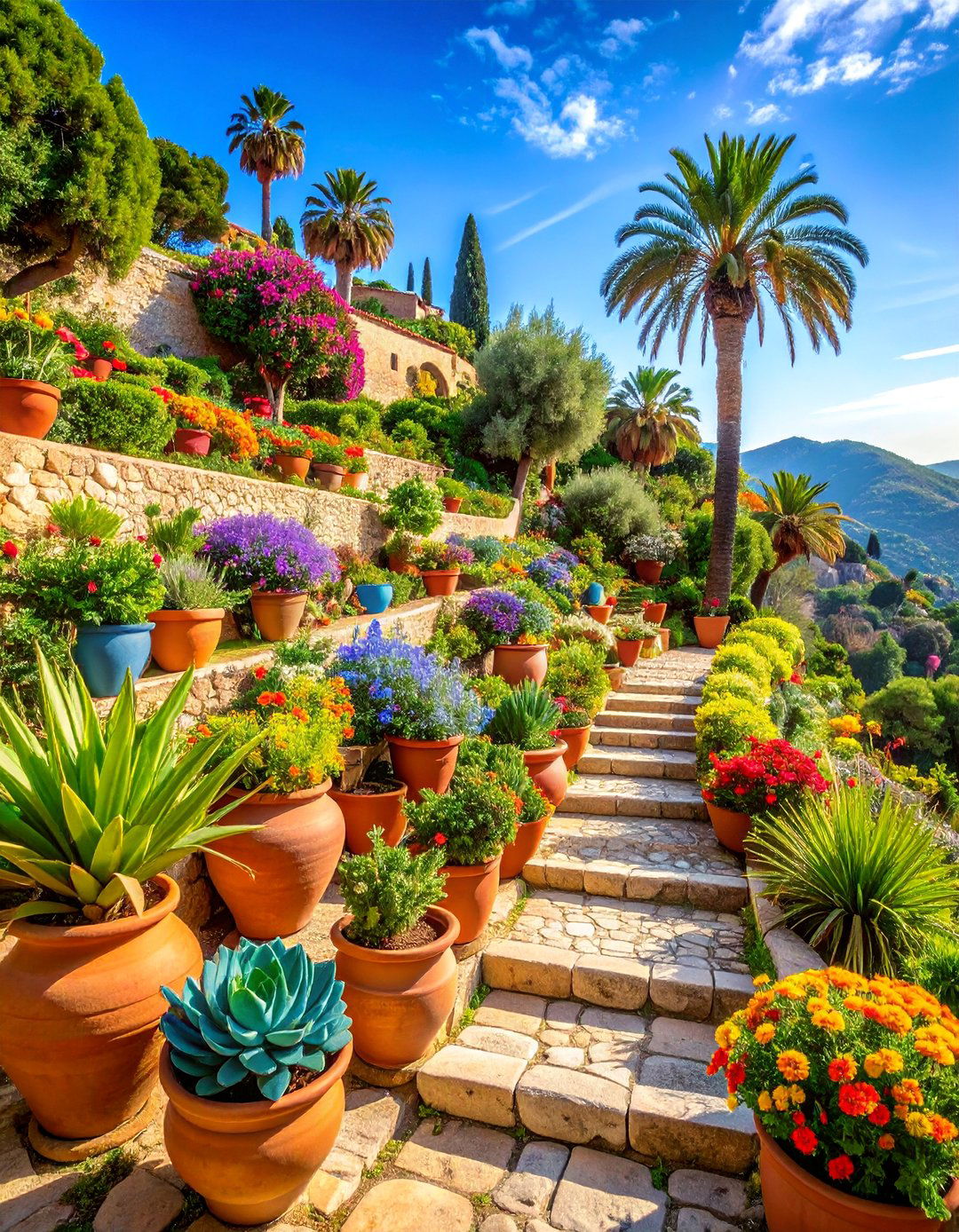
Design a charming hillside village garden featuring stepped terraces that maximize growing space while creating beautiful visual layers. Natural stone retaining walls support level planting areas filled with productive and ornamental plants including vegetables, herbs, and flowering perennials. Traditional pathways connect different terrace levels while providing access for maintenance and harvesting. Ancient olive and fruit trees provide shade and seasonal interest throughout the terraced landscape. Simple water features including stone channels and collection basins provide irrigation while adding cooling sounds. Terra cotta storage vessels and traditional pottery add authentic village character while serving practical functions. The design emphasizes sustainable practices including water conservation and organic growing methods. Comfortable seating areas positioned at scenic overlooks provide perfect spots for appreciating garden productivity and natural beauty. This garden celebrates the village tradition of creating productive landscapes that support community food security while maintaining beautiful proportions.
21. Coastal Fortress Garden with Defensive Plantings
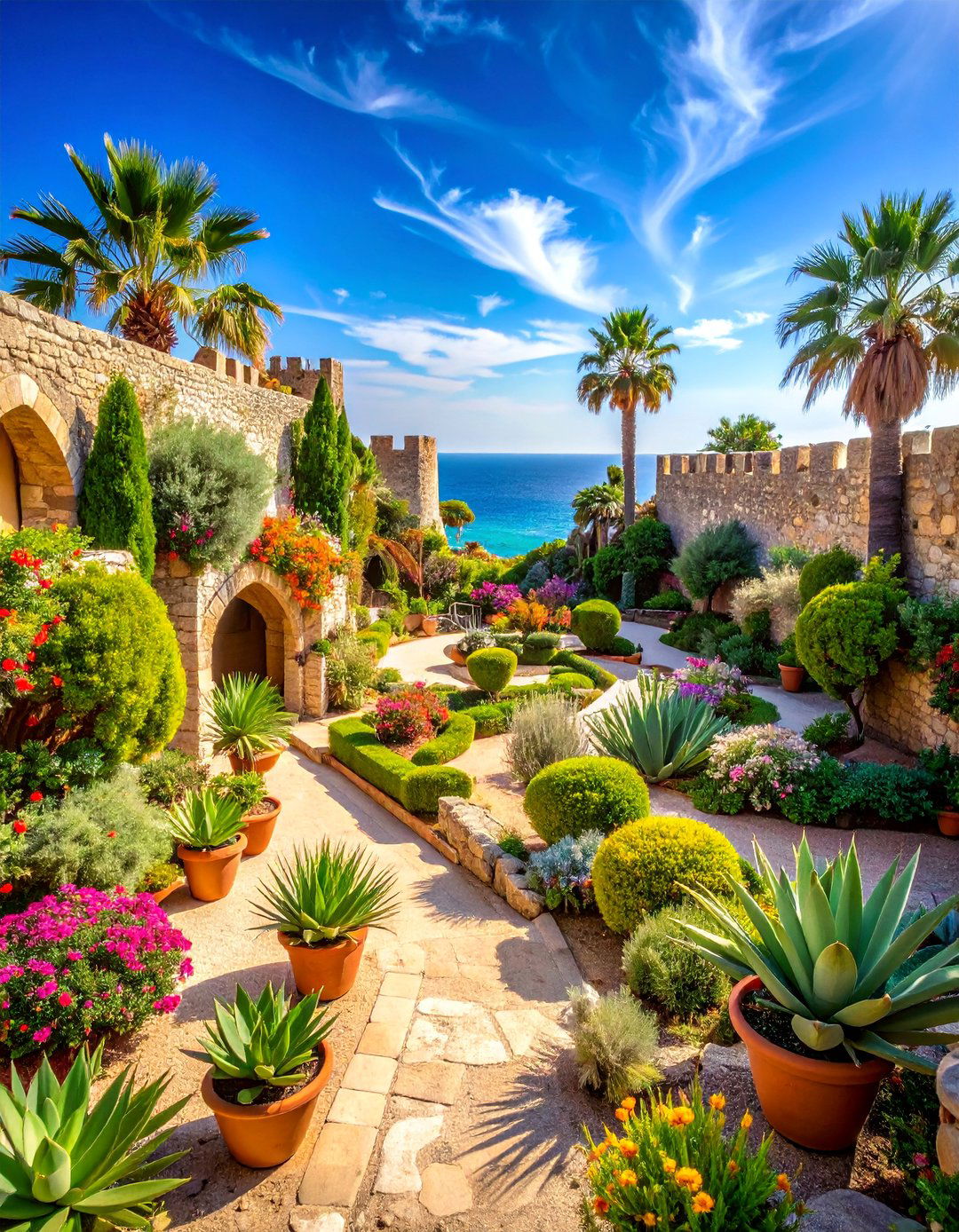
Create a fortress-inspired garden that combines protective functions with beautiful Mediterranean plantings suitable for exposed coastal locations. Strong stone walls provide wind protection while supporting climbing plants including bougainvillea and grape vines. Defensive plantings include thorny shrubs and dense hedges that provide security while creating habitat for beneficial wildlife. Central courtyards feature formal arrangements of drought-tolerant plants including lavender, rosemary, and ornamental grasses. Ancient olive trees provide shade and windbreaks while maintaining the fortress character. Water features include cisterns and channels that demonstrate traditional water conservation methods. The design emphasizes durability and low maintenance while creating beautiful outdoor living spaces. Terra cotta elements and traditional pottery add cultural authenticity while serving practical storage functions. This garden celebrates the integration of defensive architecture with productive and beautiful landscapes that supported coastal communities through challenging historical periods.
22. Philosopher's Academy Garden with Learning Spaces
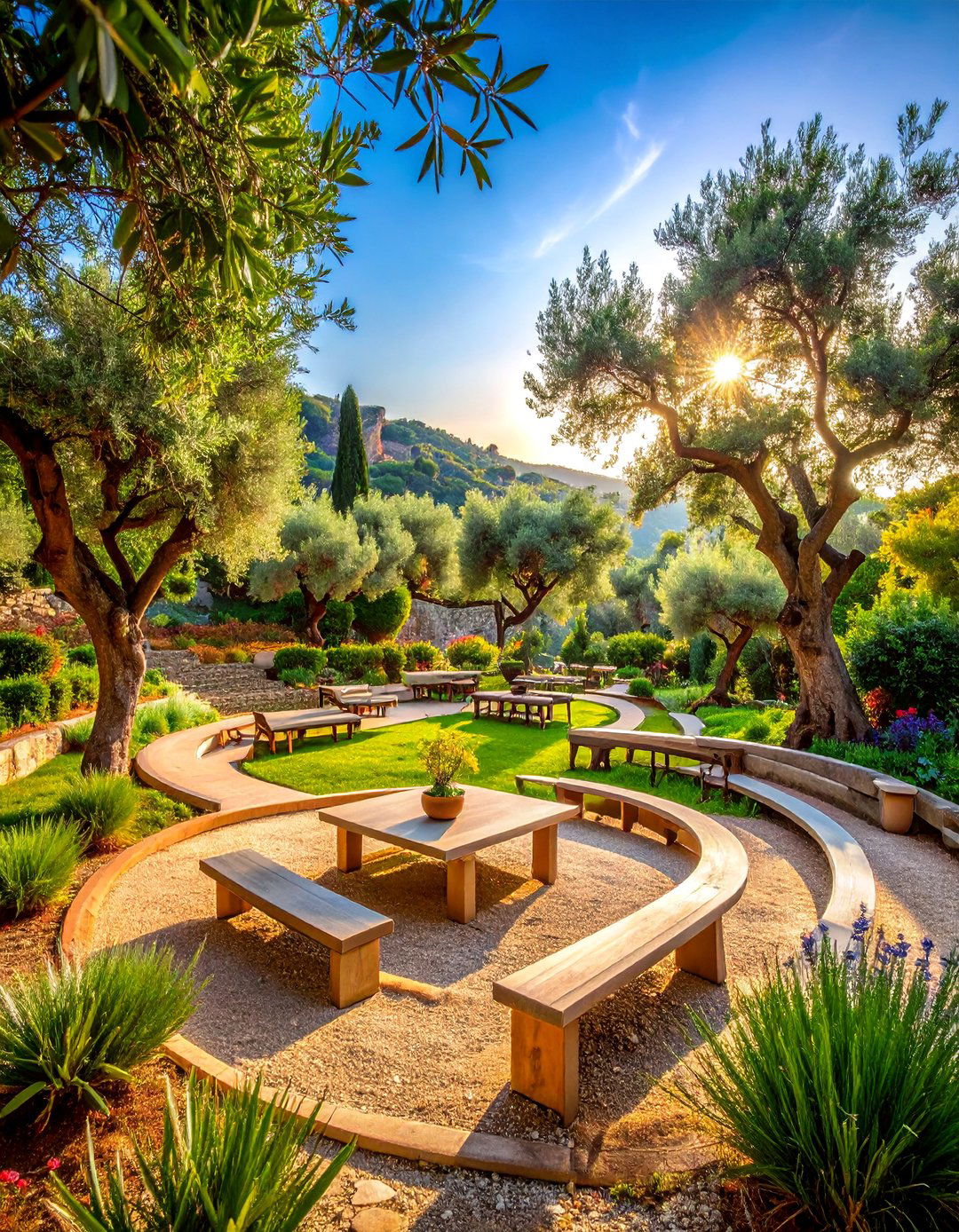
Establish an educational garden inspired by ancient philosophical academies featuring outdoor classrooms and demonstration areas surrounded by meaningful plantings. Natural amphitheater seating carved into hillsides provides gathering spaces for group discussions and presentations. Demonstration gardens showcase different plant families and growing techniques while providing hands-on learning opportunities. Ancient olive trees provide shade over study areas equipped with simple stone tables and benches. Herb gardens containing medicinal and culinary plants support practical learning about traditional plant uses. Water features including springs and fountains provide both practical irrigation and contemplative focal points. The design emphasizes accessibility and integration of different learning zones. Terra cotta elements and traditional pottery display historical artifacts while serving contemporary functions. This garden celebrates the Greek tradition of outdoor education and the integration of practical knowledge with philosophical contemplation in beautiful natural settings.
23. Island Monastery Garden with Enclosed Courtyards

Design a peaceful monastery garden featuring enclosed courtyards that provide protection from harsh island winds while creating contemplative spaces. High stone walls define intimate garden rooms filled with aromatic herbs and flowering plants that support spiritual practices. Central courtyards feature simple water fountains surrounded by geometric herb gardens arranged for easy maintenance and harvesting. Ancient olive trees provide shade and spiritual symbolism while anchoring different courtyard spaces. Traditional cells or alcoves carved into walls provide private meditation spaces overlooking garden beauty. The design emphasizes simplicity and functionality while maintaining aesthetic harmony. Terra cotta elements including storage vessels and decorative pottery reference monastic traditions while serving practical purposes. Climbing plants including grape vines and jasmine soften wall surfaces while providing seasonal beauty. This garden celebrates the monastic tradition of creating enclosed paradises that support both physical sustenance and spiritual development through careful cultivation of plants and spaces.
24. Ancient Theater Garden with Performance Spaces
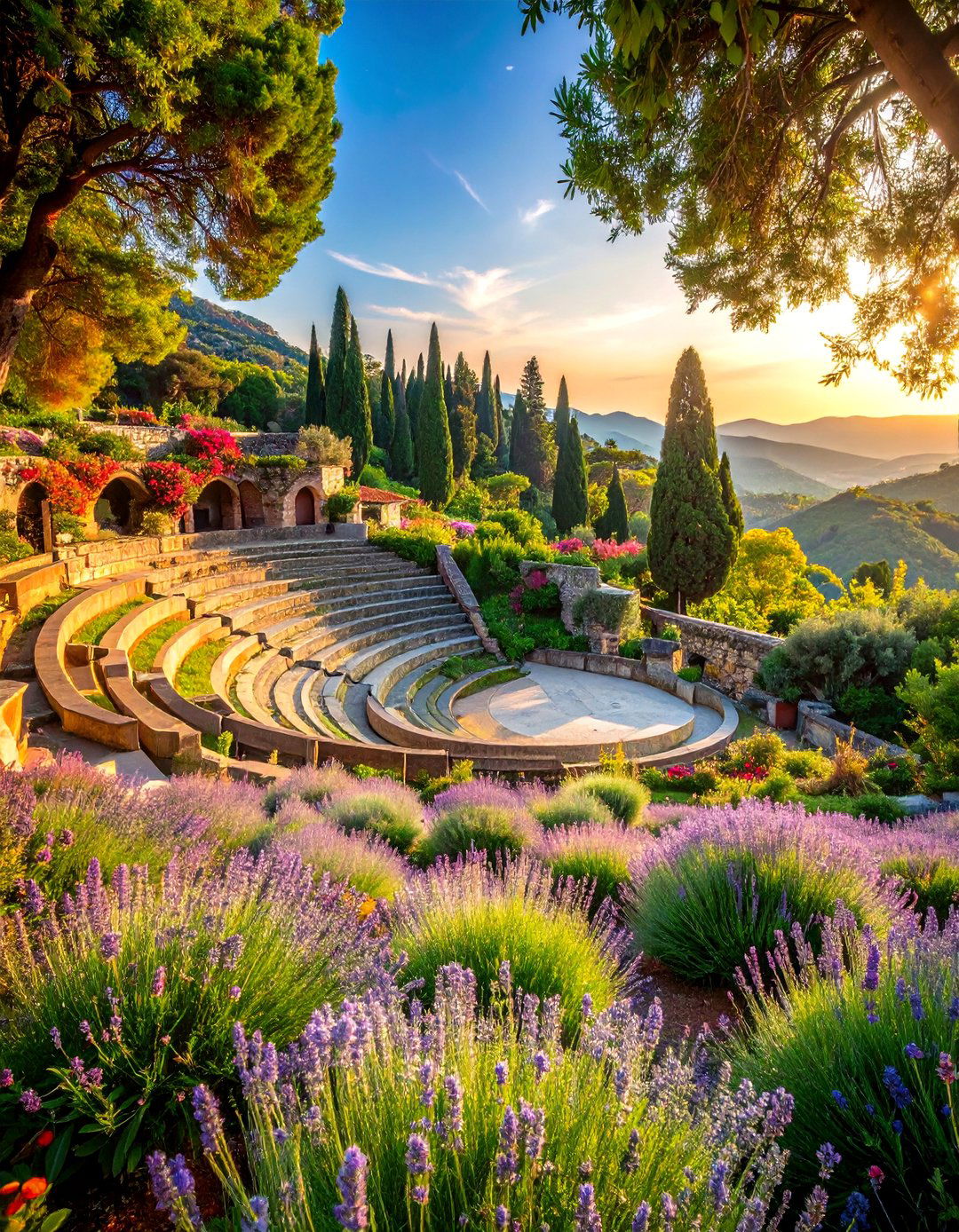
Create a dramatic theater garden featuring natural amphitheater seating carved into hillside terrain with stage areas surrounded by beautiful Mediterranean plantings. Stone seating follows natural contours while providing excellent sightlines for performances and gatherings. Stage areas feature simple stone platforms surrounded by aromatic herb gardens that perfume evening performances. Ancient olive and cypress trees provide natural stage backdrops while creating acoustic benefits. Surrounding gardens feature drought-tolerant plants including lavender, rosemary, and ornamental grasses arranged in naturalistic drifts. Traditional pathways connect different seating levels while providing access for performers and audiences. Water features positioned strategically provide cooling sounds without interfering with performances. The design emphasizes integration with natural terrain while creating functional performance spaces. This garden celebrates the Greek tradition of outdoor theater while demonstrating how landscape architecture can enhance cultural activities through thoughtful design and plant selection.
25. Royal Palace Garden with Formal Parterres
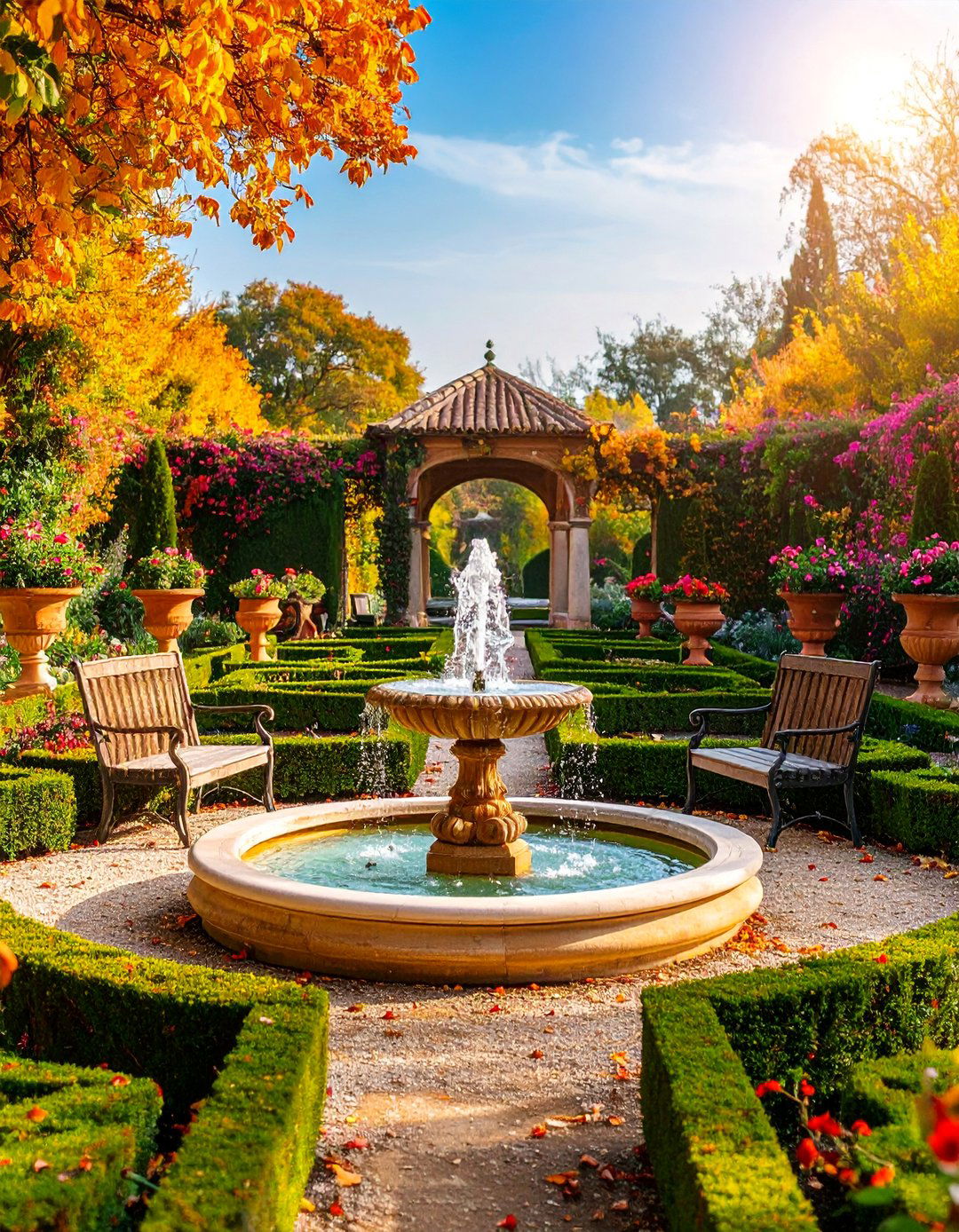
Design an elegant palace garden featuring formal parterres filled with aromatic herbs and flowering plants arranged in geometric patterns inspired by classical Greek design principles. Boxwood hedges create intricate knot garden patterns filled with colorful seasonal plantings including herbs, bulbs, and perennials. Central water features including elaborate fountains provide cooling elements while serving as geometric focal points. Ancient olive and cypress trees provide vertical structure while maintaining formal garden proportions. Natural stone pathways connect different parterre sections while providing access for maintenance and appreciation. Traditional seating areas feature marble benches positioned to overlook different garden vistas. The color palette emphasizes classic combinations including blue, white, and gold that reference royal traditions. Terra cotta urns and decorative pottery add authentic cultural elements while containing specialty plants. This garden celebrates the sophisticated design traditions that evolved from classical Greek principles through royal patronage and demonstrates how formal gardens can integrate productivity with ornamental beauty.
Conclusion:
Greek gardens represent the perfect marriage of ancient wisdom and timeless beauty, offering inspiration for creating outdoor spaces that celebrate both human achievement and natural harmony. These twenty-five garden concepts demonstrate how traditional Mediterranean design principles can be adapted to diverse settings and personal preferences while maintaining authentic character. From intimate courtyard retreats to dramatic hillside terraces, each design emphasizes the fundamental Greek values of proportion, functionality, and integration with natural systems. By incorporating drought-tolerant plants, natural stone materials, and time-tested design elements, these gardens provide sustainable beauty that improves with age. Whether you choose a single concept or combine elements from multiple designs, these Greek-inspired gardens will create lasting outdoor sanctuaries that honor ancient traditions while serving contemporary lifestyle needs.


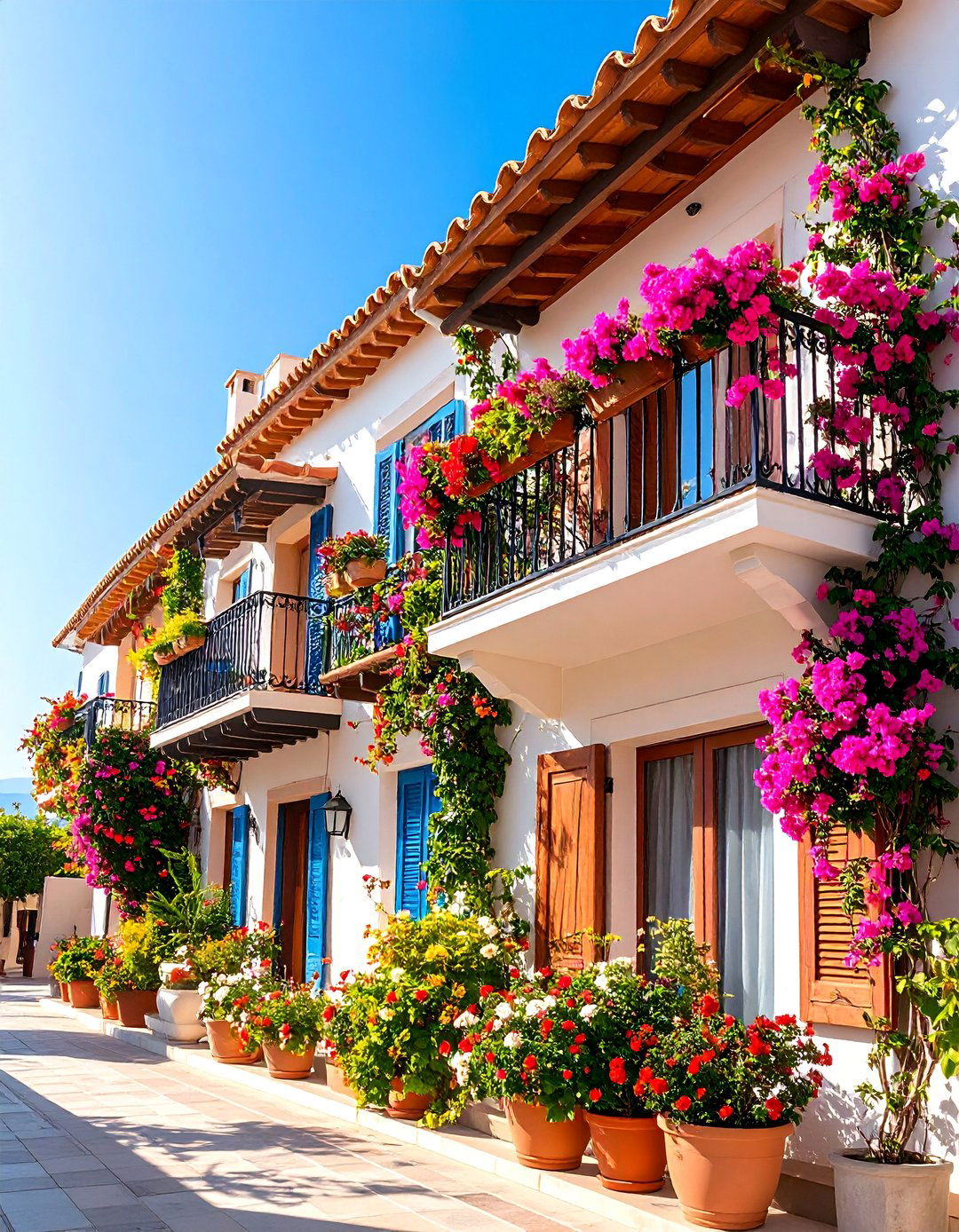
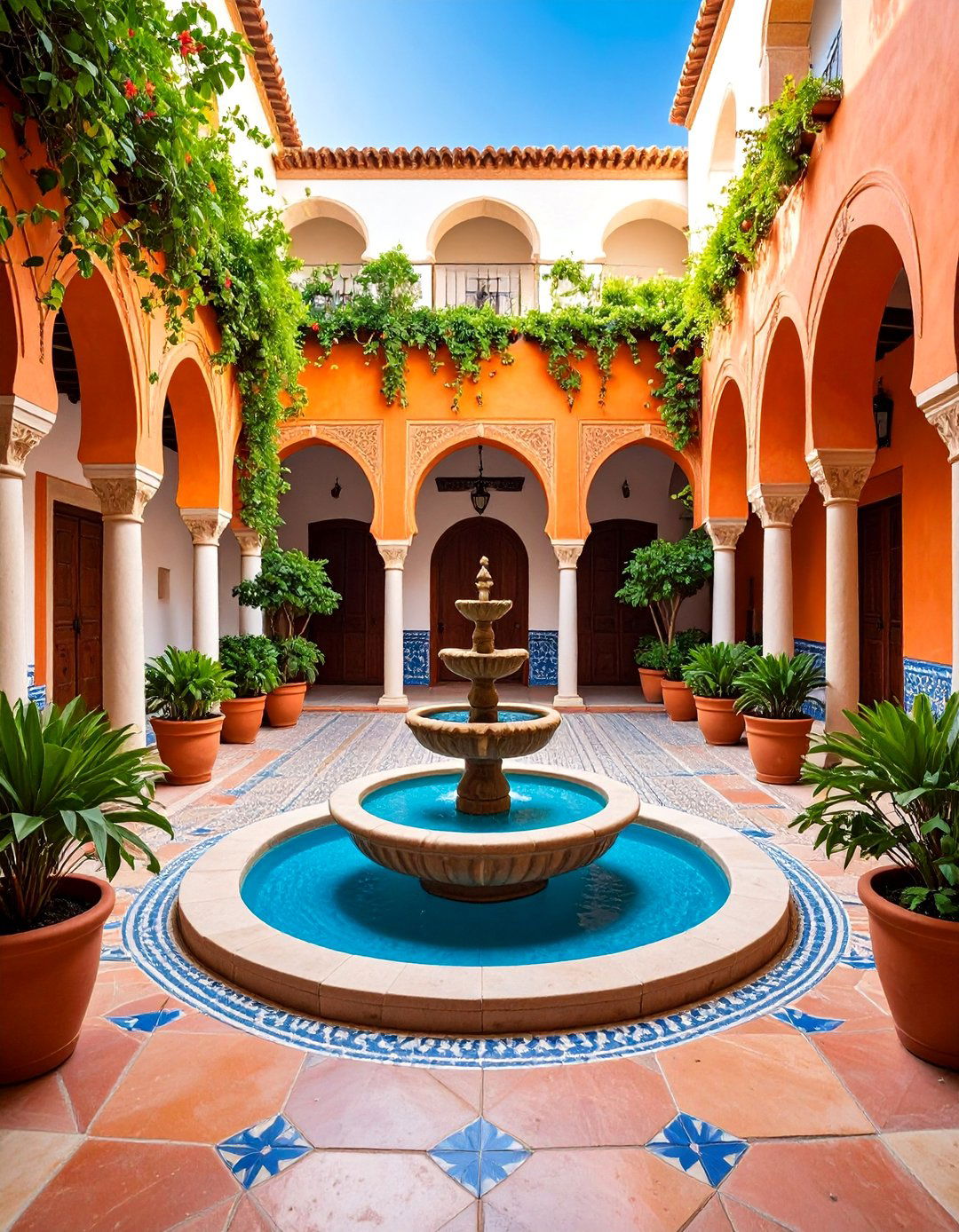

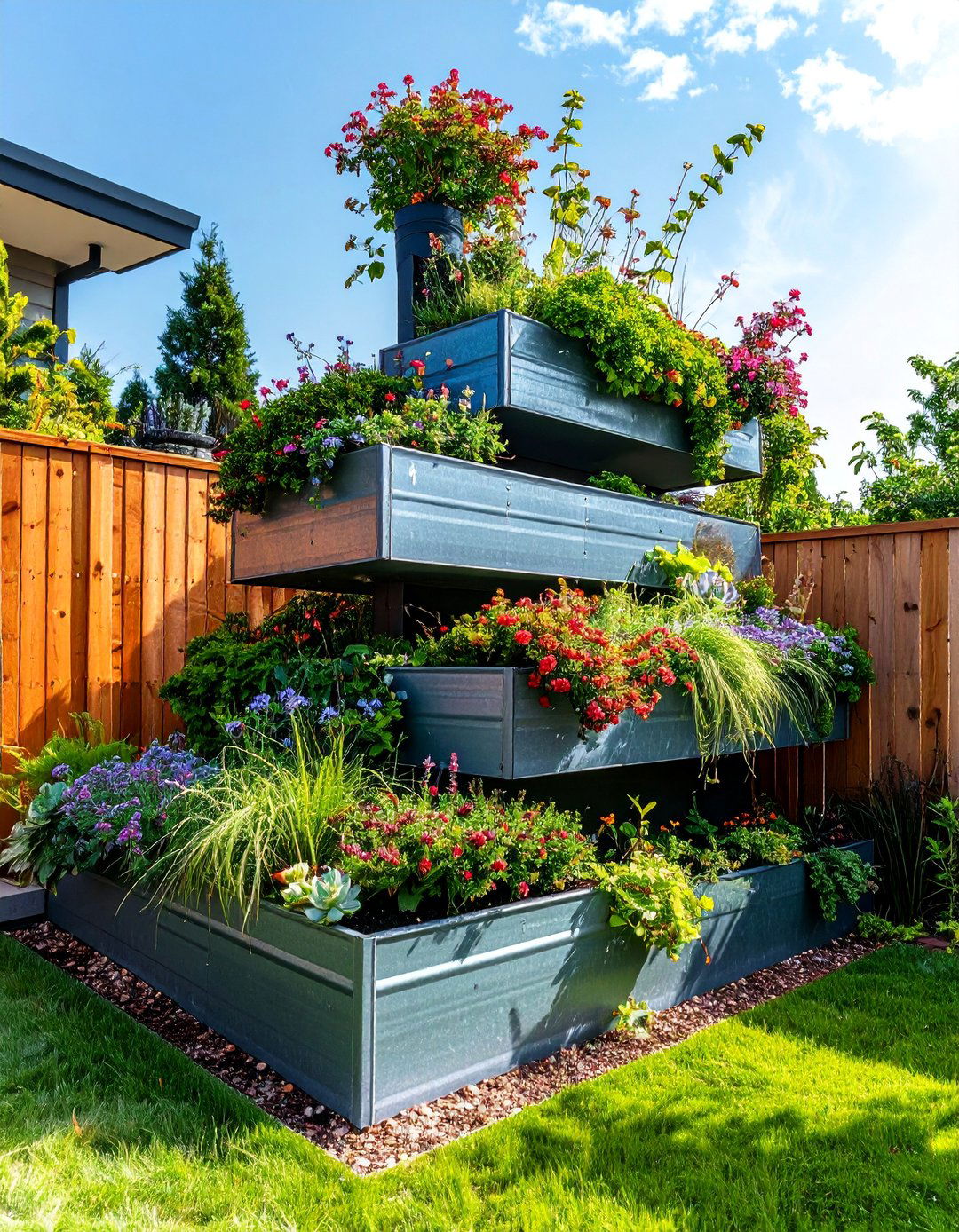
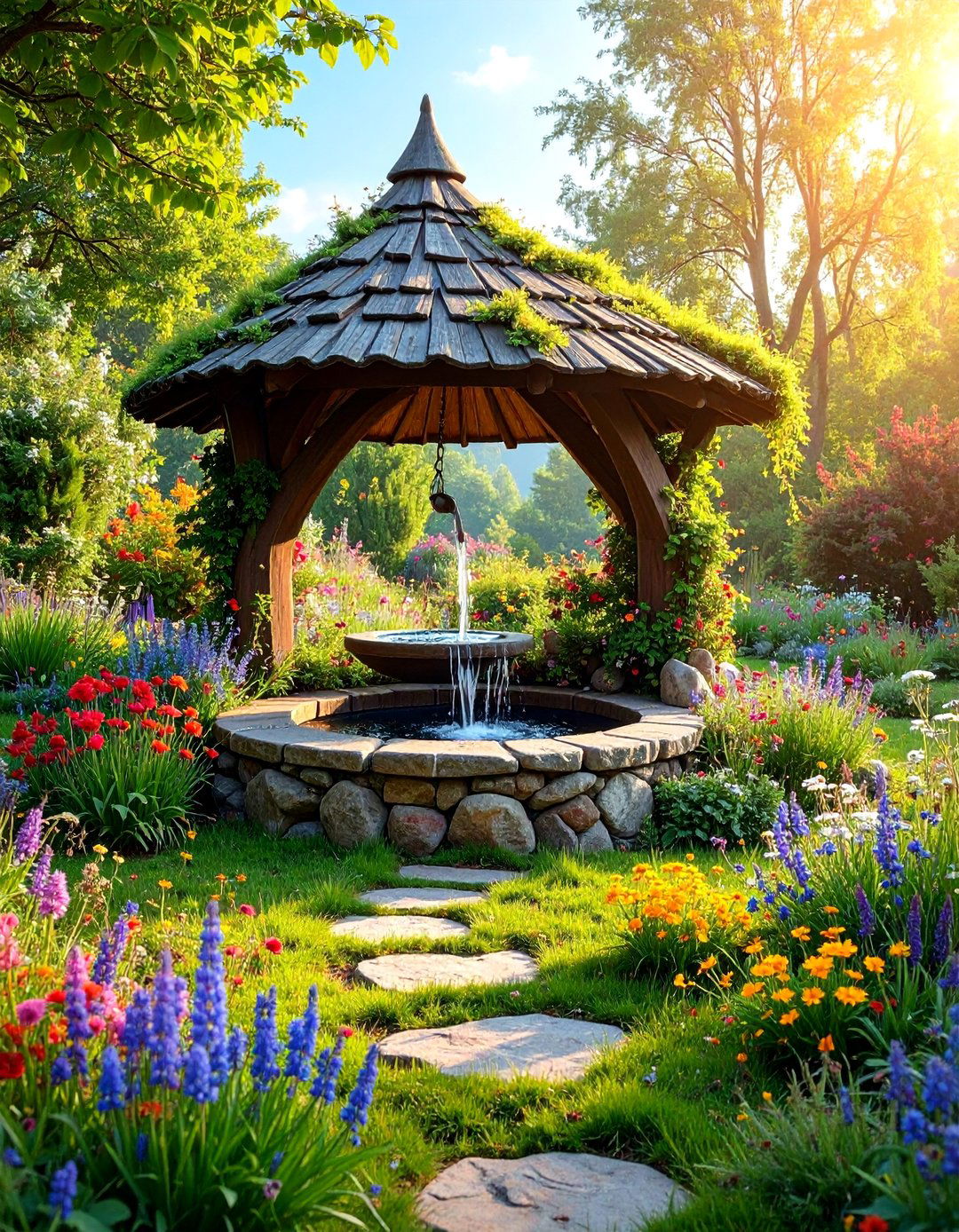



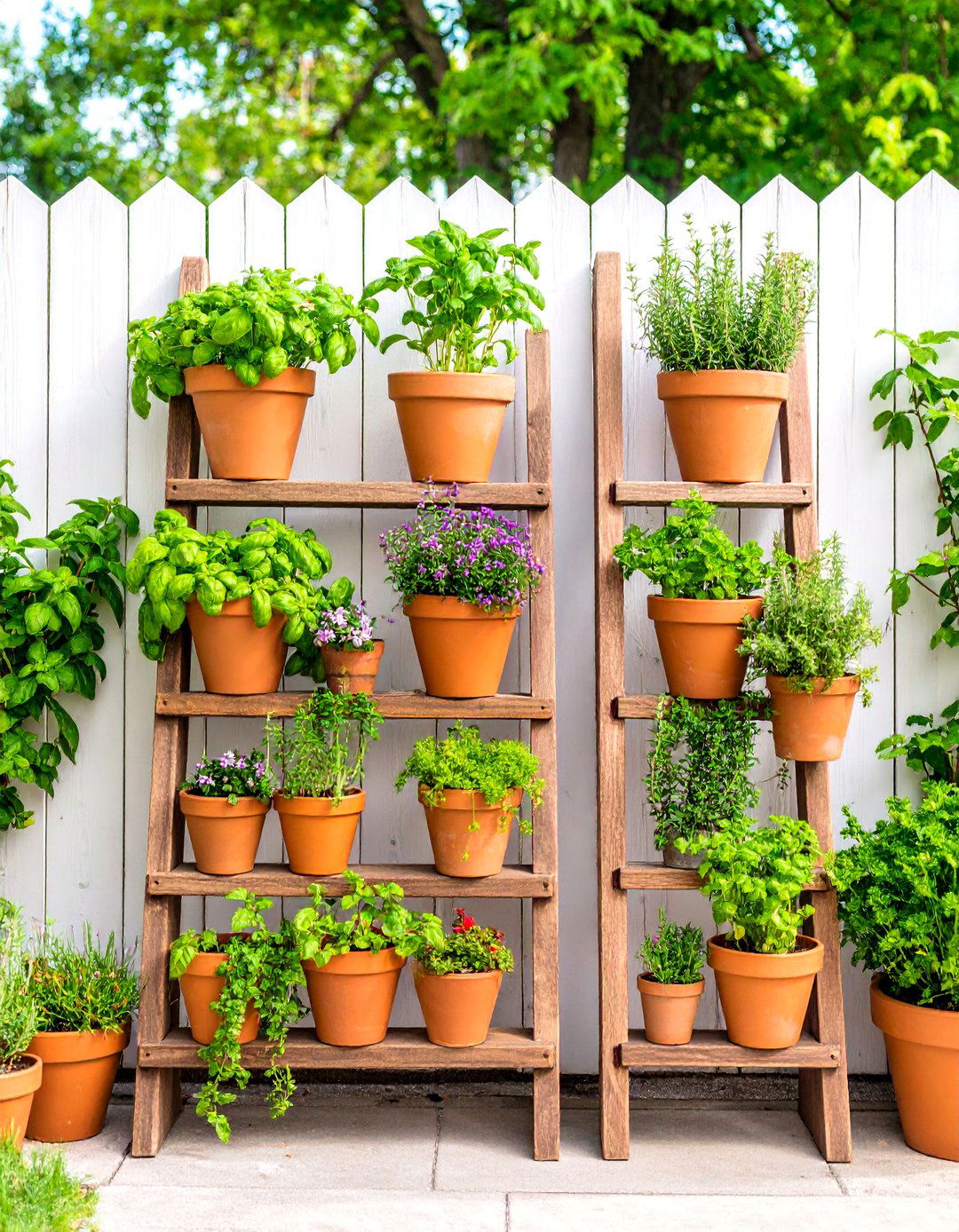

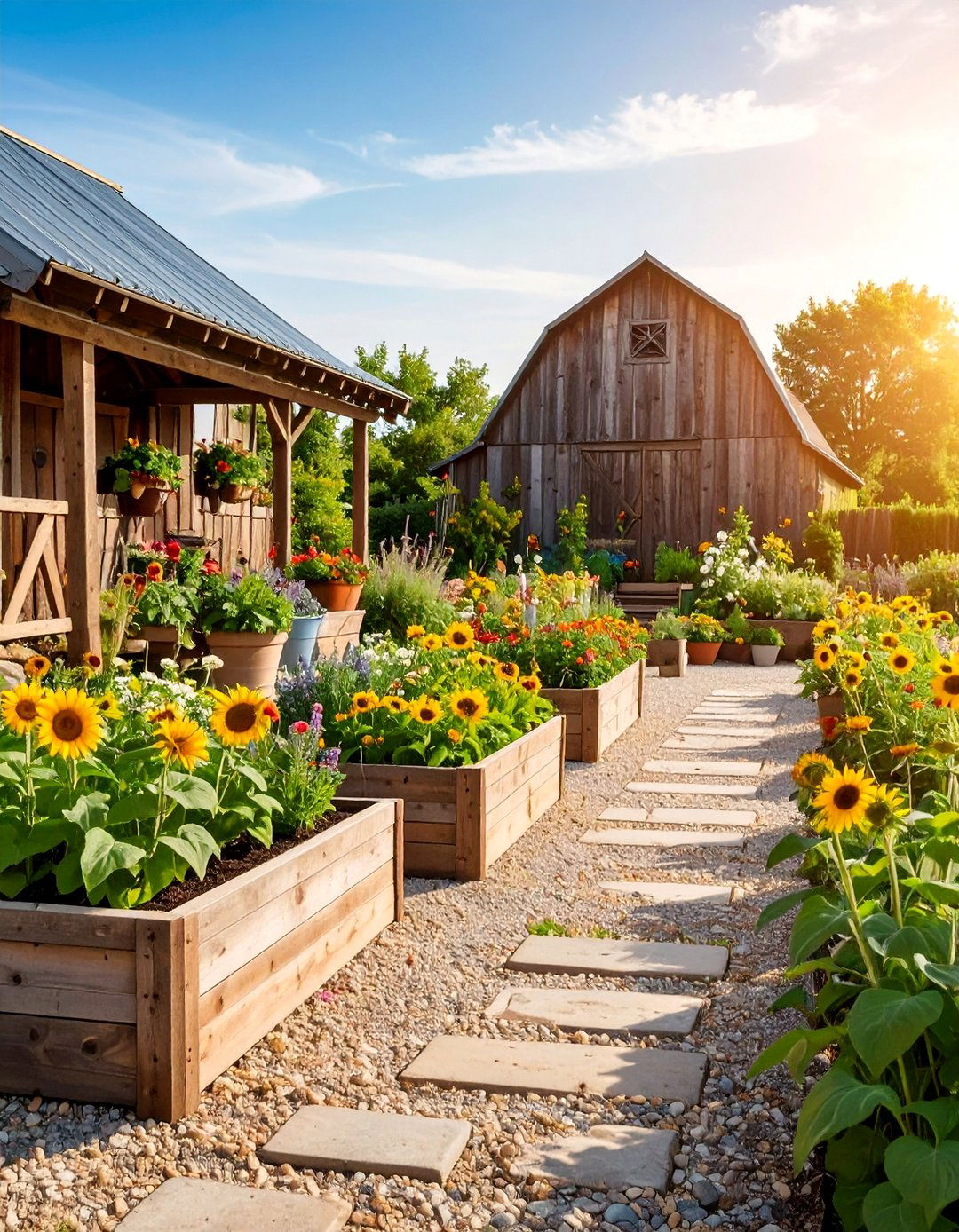

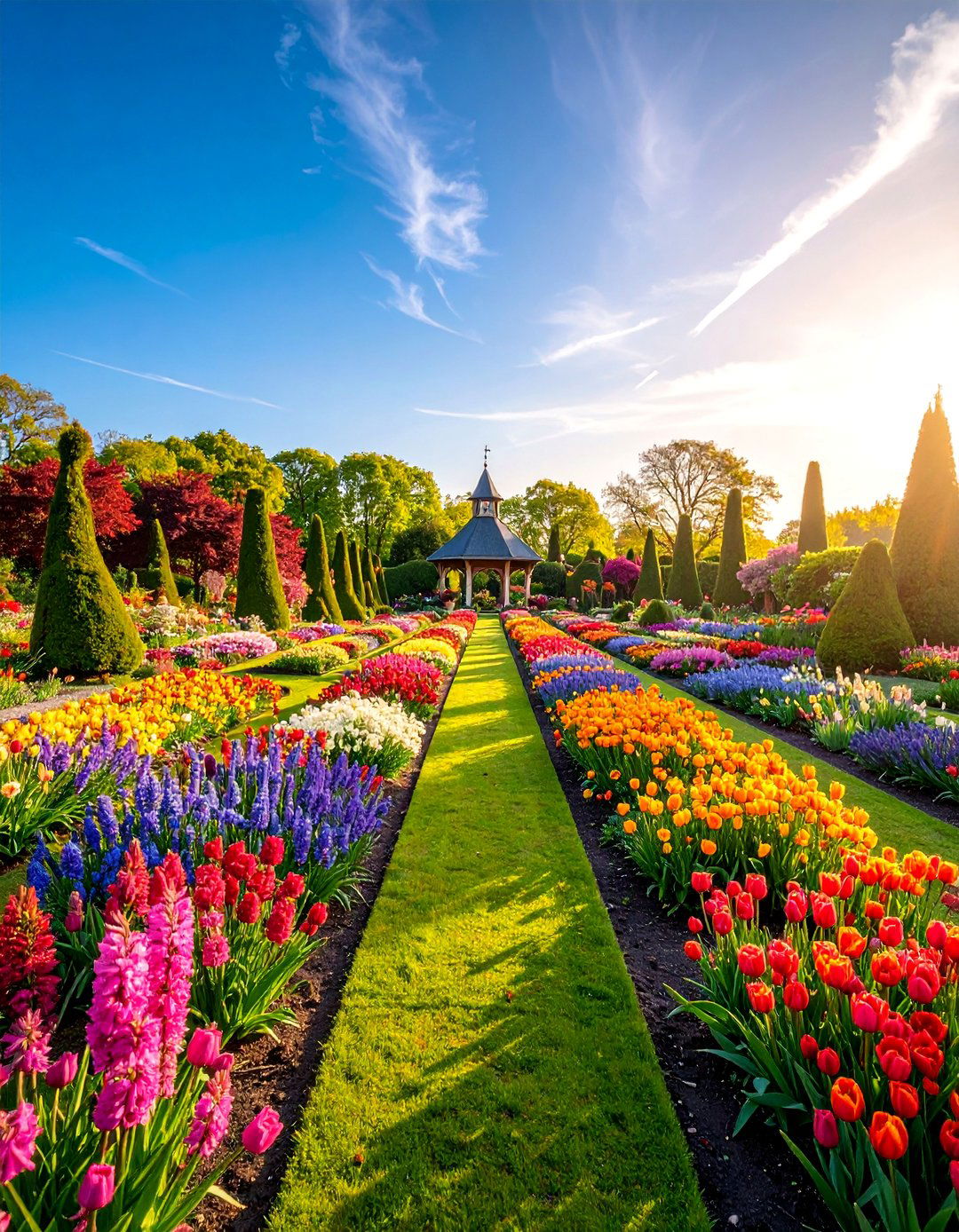


Leave a Reply